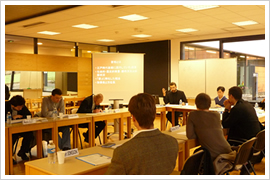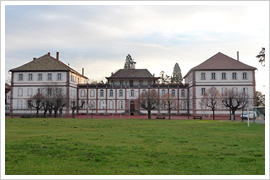Activity Reports:Japanese Studies and Intellectual Exchange:Report on the Japan-Europe Intellectual Exchanges in Alsace: A collection of papers "Japanese Studies Seminar on Edo" is published
Europe, Middle East and Africa Section
Japanese Studies and Intellectual Exchange Dept.
Centre Europeen d'Etudes Japonsaises d'Alsace (CEEJA) is housed in the building that was formerly used as the student dormitory of Seijo Gakuen High School in Alsace, which is surrounded by vineyards on three sides, a place of scenic beauty where the mountain range in Alsace can be enjoyed. In such an ideal atmosphere, the Japan Foundation and CEEJA co-organized "Japanese Studies Seminar on Edo" in 2008 and 2009. Professor Yuko Tanaka of Hosei University was invited to be the lecturer at the seminar, and up and coming European researchers came together to present papers and exchange ideas.
Now, it is our pleasure to publish the collection of papers by the participants of this seminar.
 The first thing that may surprise the reader is a wide variety of themes and approaches these papers employ, not to mention the participants' superb expertise and outstanding competency of the Japanese language with which they devoured both contemporary documents and materials from the Edo period, made oral presentations, engaged in discussions, and wrote academic papers. This is obvious just looking at the intriguing titles of papers.
The first thing that may surprise the reader is a wide variety of themes and approaches these papers employ, not to mention the participants' superb expertise and outstanding competency of the Japanese language with which they devoured both contemporary documents and materials from the Edo period, made oral presentations, engaged in discussions, and wrote academic papers. This is obvious just looking at the intriguing titles of papers.
A research on folk beliefs in Mt. Fuji, for example, pointed out that Mt. Fuji has historically been deified in various ways. For example, the summit of Mt. Fuji was used to resemble Amida trinity or the mountain itself was considered as the center of the world (Axis Mundi). People in the Edo period tried to be unified with the deity through ascetic training in the cave at the foot of Mt. Fuji, conferred femininity upon the mountain itself, and built Fujizuka across the country as replicas of "Holy Fuji." Rich sources of paintings and figures are used to support the theory. It conceives the belief in Mt. Fuji as a belief structure (episteme) of the general public in the Edo period, rather than systematic religion or thoughts. It reveals the source of the feelings that the Japanese have been holding for Mt. Fuji up to today (Gottardo "Beliefs in Fuji and episteme of the common people (framework of thoughts)").
Another researcher scrutinized the documents on the food pipeline for the Korean envoys to highlight how the Tokugawa shogunate and the domain of Tsushima dealt with financial deterioration, while supplying the Korean envoys with food with the intention of maintaining the friendship between the two countries and showing off the authority of the shogunate. This study invokes issues of today's Japanese politics, such as discord and bargaining between foreign diplomacy and national politics as well as between the central government and local municipalities. (Grepinet "The food pipeline for the Korean envoys in the Edo period")
 The study of the massive arrests of Christians in the mid-17th century illustrated various aspects of the incident by using Japanese, English, and Portuguese (written by missionaries) documents. It described the actual situation of Christian communities that were supposed to have been banned by the Edo shogunate, local domains' acknowledgement of such communities, an apocalyptic vision that was unique to Japan, and so on to reveal that persecution was not the sole attitude toward Christians in that period. (Nogueira Ramos "The image of Christian community in the stronghold of Omura seen through the Kori Kuzue (1657-1658)").
The study of the massive arrests of Christians in the mid-17th century illustrated various aspects of the incident by using Japanese, English, and Portuguese (written by missionaries) documents. It described the actual situation of Christian communities that were supposed to have been banned by the Edo shogunate, local domains' acknowledgement of such communities, an apocalyptic vision that was unique to Japan, and so on to reveal that persecution was not the sole attitude toward Christians in that period. (Nogueira Ramos "The image of Christian community in the stronghold of Omura seen through the Kori Kuzue (1657-1658)").
There is another study that excites one's spirit of romantic adventure with topics that are likely to be found in a full-length historical novel. During the 16th and 17th century when Japan closed the door to foreign countries, there was a broad network that covered Southeast Asia in which Chinese people in Nagasaki acted as middlemen, and merchants, pirates, the shogunate, and the Dutch East India Company mingled with each other (in fact, the Zheng family that produced the famous Zheng Chenggong was at the core of the network). (Carioti "Basic study of Chinese in Nagasaki during 16th and 17th centuries"; the result of the study will be published soon.)
This collection also includes other interesting studies; for example, a study on the physiognomy of a house as divination (Hayek "The domomancie of Matsuura Kinkaku (19thcentury): tradition with modern accents"), a study of evil and monster in the story of "Kachi-Kachi Yama" in Akahon (picture book) for children (Micyk "Aspects of evil in Kusazôshi - Akahon, Monster as a symbol of evil"), and a study of the holistic medicine in the Edo period (Zentai "Introduction of Kaibara Ekken and his writing "Yôjôkun" and its Present Meanings").
All of these studies are approached from perspectives that are different from those of Japanese or researchers in Japan and, as Professor Tanaka pointed out, with an attitude to understand the history of Japanese thoughts and components of culture through their research materials in order to achieve broader scope of study on Japanese culture. The insights gained from these studies will be useful for the Japanese researchers who pursue Japanese studies within Japan. Supporting Japanese studies abroad, as part of international cultural exchange, can nurture diverse perspectives on Japan, enhance Japanese studies as a whole, and ultimately deepen the understanding of Japan abroad
This collection of papers (in Japanese only) is available at the JFIC Library and other university libraries in Japan. It can be delivered to those who are interested, although the numbers are limited.
Related Articles
Back Issues
- 2025.9.30 The 51st Japan Found…
- 2025.9.30 The Japan Foundation…
- 2025.9.30 Bringing the World C…
- 2025.9.30 The 51st (2024) Japa…
- 2025.9.30 Japan Foundation Pri…
- 2024.5.24 The 50th Japan Found…
- 2024.3. 4 Movie Theaters aroun…
- 2023.4.10 The 49th Japan Found…
- 2023.3.28 JF's Initiatives for…
- 2023.1.27 Living Together with…

